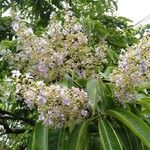smaller, leaflets chartaceous, mostly drying uniformly grayish-green on both sur-faces, the central one oblong-elliptic or elliptic, 4-17.5 cm long and 2.2-7 cm wide, apically acuminate or caudate, varying to acute or even obtuse on smaller leaflets, entire or wavy-margined, abruptly acute or short-acuminate basally, minutely and obscurely puberulent on both surfaces or glabrous and shiny, the lateral pair similar but apically less caudate; petioles 3-7.5 cm long, sparsely and minutely pulverulent-puberulent, glabrescent; petiolules 3-19 mm long, slender, conspicuously canaliculate and minutely pulverulent or glabrate. Inflorescences axillary and terminal, paniculate-thyrsoid, erect or ascending, pinkish-gray, 10-21 cm long and 4.5-13.5 cm wide, often with 1-5 opposite pairs of paniculate branches, sometimes simple, each panicle of 4-10 or more pairs of stipitate, flowered cymes; peduncles 2-4 cm long, the rachis and inflorescence-branches slender, similar to the twigs in texture, color and puberulence or sometimes densely canescent-puberulent; pedicels mostly obsolete; foliaceous bracts often present in the larger thyrsoid inflorescence, 2-3-foliolate, long-stipitate, similar to the leaves but much smaller; bractlets and prophylls linear, 1-3 mm long or less, caducous. Flowers with the corolla blue or light-blue to purplish-blue or purple. Fruit black, ca. 8 mm wide.
More
Often much gnarled tree to 17 m tall, trunk to 90 cm d.b.h., branched from below the middle; branchlets mostly ampliate and thickened at the nodes, obtusely tetragonal, gray, lenticellate, glabrous; twigs buff or brownish, usually conspicu-ously white-lenticellate, minutely puberulent with short canescent or brownish hairs, glabrescent. Leaves 3-foliolate; leaflets subequal or the lateral 2 slightly
Can be grown by seedlings. Seeds needs soaking.


